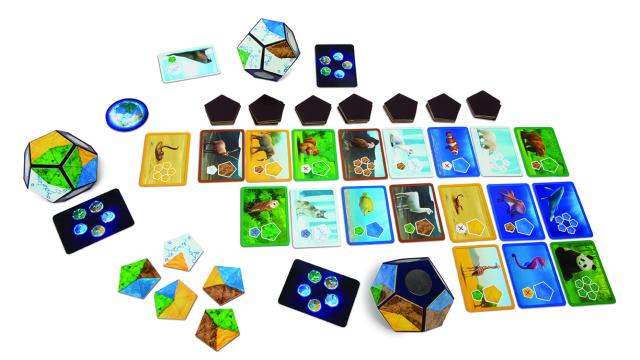A new award-winning board game asks you to do a seemingly simple task: Build the perfect planet for wildlife.
Planet, a board game by Blue Orange Games that dropped on Earth Day, is a fast-paced, beautifully designed, kid-friendly game that everyone, regardless of whether they are an environmentalist, can appreciate. It challenges players to build their own planets for whatever animals chance has laid out for them. Collect enough animals, and you just may win.
The game requires players to be mindful of what sort of habitat is necessary to support a wide range of creatures — and in that way, it offers a lesson that couldn’t come at a better time, given our planet’s ongoing ecological crisis.
While new species — from deep sea corals to whales — are still being discovered, we’re losing a whole lot of species, too. In fact, dozens may be going extinct every day, according to the Center for Biological Diversity. The main culprit is habitat loss.
Planet may take place on fantasy worlds, but it reminds us that we, ultimately, have the power to shape habitats all life depends on.
That’s part of the point, said Urtis Sulinskas, who designed the game, in an email to us. Players can learn about “the beauty and diversity of the living species that are living on planet Earth” and “the importance of creating and preserving natural environments,” he wrote.
Here’s how you play: Up to four people receive a 3D planet they can stick landscape tiles onto via magnets. These tiles include desert, grass, ice, ocean and mountain areas.
Each turn, the players pick one of these tiles and, starting by the third turn, they can select animal tiles too. But you need to have the right habitats in place in order to do so, and every animal has its own requirements.
For instance, the penguin needs its planet to be mostly ice, but that ice must touch water. The blue whale needs a planet with five ocean regions. The Fennec fox requires a planet with mostly desert that isn’t touching any mountain land.
The players win points based on how many animal cards they grab, plus what type of habitats they accumulate. Having a variety of environments for all the different animals is important. When your globe runs out of space for more of them, you’re finished. The entire gameplay takes about 30 minutes.
“Choosing the right terrain combinations and placing them wisely while observing other players is the key to victory,” Sulinskas said. “However, in the end, there is a pleasant feeling for each player holding their own unique planet, that they have designed.”
The game’s concept is dope as hell. Players may come across animals they don’t recognise among the game’s 45 cards. There were definitely some animals I cocked my head at.
My biggest criticism of the game is that the cards don’t include animal names — and I so wish they did. That’d add a new level of education, especially for the younger or less-informed players.
And the habitats for some animals didn’t make all that much sense to me. Like, the meerkat needed mostly desert, which, OK, word. It lives in deserts throughout Africa. But the meerkat card also requires that the desert touch ice habitat, and, um, there is not much ice near the real meerkat’s deserts.
The tiger card similarly confused me, because while all tiger species do live near some type of forest ecosystem, they aren’t typically found near deserts, which the card lists as a requirement.
During the game, though, you’ll probably more focused on selecting the habitat tiles that suit the animals before you than how scientifically accurate each one is.
Every player gets a “Natural Habitat Objective Card” that offers points for the amount of habitat you accrue related to the card, but the rewards are comparably small. Animal cards offer the most points, and without them, there’s no way you’re winning.
Like most board games, this one takes some practise. My first two rounds involved a lot of back and forth with my housemates regarding the rules. I didn’t win any rounds initially, but by my second sesh when I played with my boyfriend (this is a two person-friendly game), I had my strategy down to a science, building my largest habitat regions around what the animal cards on the table demanded.
Next on my agenda is to play this game with my nephew. I’m curious how a nine-year-old would respond to its very specific rules, and I wonder how many of these animals he’ll recognise.
Most of all, I hope he’ll get a hang of the game’s primary objective: Build the planet our animals need. Because that’s something future generations need to understand.
